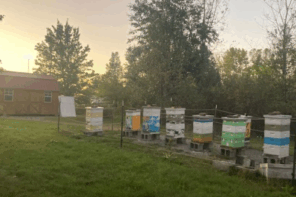John Miller
Science is hard.
The beekeeping industry doesn’t fund a lot of bee research science.
We do some very good science – but the amount of funding available to conduct good, rigorous scientific bee research is comically/tragically small. You’ve heard me say before: ‘Apple computer spends more per second on research than beekeeping spends in a year.’
Beekeepers and almond growers are aligned. The almond growers seek the maximum return on orchard investments. Beekeepers seek the maximum return on beehives. Almond growers and beekeepers gather and sort information from lots of sources.
Beekeepers and almond growers have a bit of a dilemma. I’m thinking of a 15-year-old opportunity beekeepers and almond growers have not resolved. Hive stocking rates. For many years – a boilerplate recommendation, indeed language in almond acreage crop insurance states the grower shall have two hives per acre (hpa) to qualify for crop insurance. How quaint. A grower can rent garbage hives into his garbage orchard and obtain a return on his policy. This is bad for both industries – and it’s long past time to re-visit hpa stocking rates. It’s especially important to re-visit hpa stocking rates in the so-called self-fertile varieties.
A few terms beekeepers should be comfortable with: Self-fertile = Pollen from the flower will fertilize the ovule within that flower (and other flowers of the same variety).
Self-pollinating = Transfer of pollen actually occurs within the flower, without the use of an external vector, typically insects.
Self-fruitful = a mash up of the prior two terms.
Unpublished findings of ‘bagged trees’ speaks to a self-fertile tree in the absence of bees will not set enough nuts to be profitable. Published reports of almond growers who rented no bees for so-called self-fruitful bragging about 4,000 pounds per acre crop proves the point. Those trees maximize nut set with bees. Always have, always will.
The nurseries propagating these new tree varieties do a disservice to both beekeeper and almond grower by claiming ‘no bees needed here!’ This is a disingenuous claim. Believed by the bee-freeloader grower – now an almond growing neighbor’s bee mooch. A parasite. In fairness, one nursery web page states: “Research shows that independence can set full commercial crops with fewer bees.”
This is the hard part. There is no published science on an appropriate stocking rate on trees that may be self-fruitful – but do in fact benefit from the presence of bees. A lot of benefit: In the above example – over a ton per acre difference. Nurseries should modulate their claims about self-fruitful, be truthful.
An even harder truth is that in almond growing regions of California – it is nearly impossible to find a so-called self-fruitful block of trees not surrounded by traditional plantings of traditional trees. Thus, a good science test of magical nursery claims – is nearly impossible. A good science test of the ‘mooch factor’ is nearly impossible.
This stocking rate recommendation issue for traditional and self-fruitful trees is actually an opportunity.
The opportunity is in the aligned priorities of the beekeeper and the almond grower: optimize the return on investment. The variables in the opportunity formula are mostly known.
Almond growers using hive-strength contracts have an advantage. If almond growers engage with the same beekeeper over the years – she knows – based on the quality of hives her beekeeper brings, year after year, that two hpa is a higher stocking rate than necessary. The more accurate measurement is ‘frames per acre’ than hives per acre. If the Beekeeper consistently grades at 11+ frames per hive – for over a decade of hive-strength testing – the grower surely knows that 22 frames per acre exceeds the optimum nut set requirement. But! The science is hostage to the mysterious – outdated – insurance policy most growers use to arbitrage risk.
Opportunity: Change the (needlessly rigid) insurance policy terms.
I will be dead before this happens.
Almond growers planting blocks of so-called self-fruitful trees may save money formerly invested in pollination services. However, the almond grower is not entitled to mooch bees from her neighbor – and her neighbor’s rented bees will visit the so-called self-fruitful variety as evidenced by the Hughson, CA grower who rented no bees in 2021 – and mooched a 4,000-pound crop from his neighbors who did rent good bees.
This is the hard part of the science-based stocking rate recommendations.
The stocking rate science in a co-mingled planted area – which is everywhere in CA – is hard.
The priorities beekeepers and growers share are easier, more collaborative.
The grower needs every nut the tree can set.
The beekeeper needs hives to thrive – in a safe environment.
The grower may not need two hpa on so-called self-fruitful – but she does need one hpa.
The grower can strengthen the long-term relationship with her beekeeper by continuing the hive-strength contract. Advocate for a change in insurance policy language – to a more accurate stocking rate formula. This is long overdue. 15 years overdue.
So-called self-fruitful varieties are now approaching 15 years in the ground.
Traditional and self-fruitful varieties have different stocking rate needs.
Beekeepers support what growers support.
Nurseries should support optimized return on investment from almond growers, their customers. Claims should be verified. Again, a hard thing in almond acreage new and old.
A tidal wave of recently planted acreage will come online over the next five years.
Both traditional and non-traditional root stocks deserve sound stocking rate recommendations.
In the interim, a couple of suggestions:
In the absence of hard science – consider stocking traditional acreage with 1.75 hpa.
In the absence of hard science – consider stocking non-traditional acreage at one hpa.
Bees need trees. Trees need bees.
Grower success is beekeeper success.









